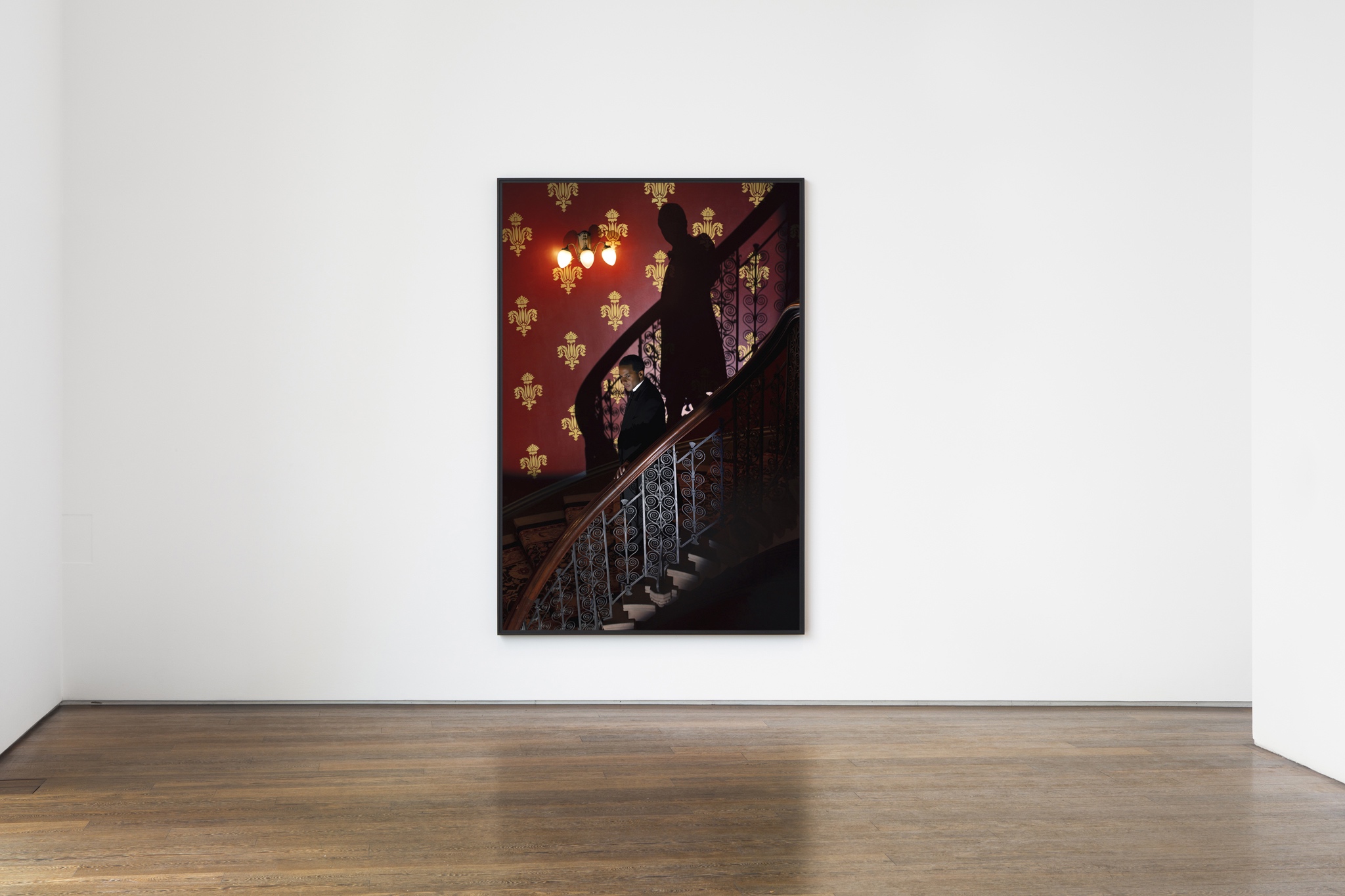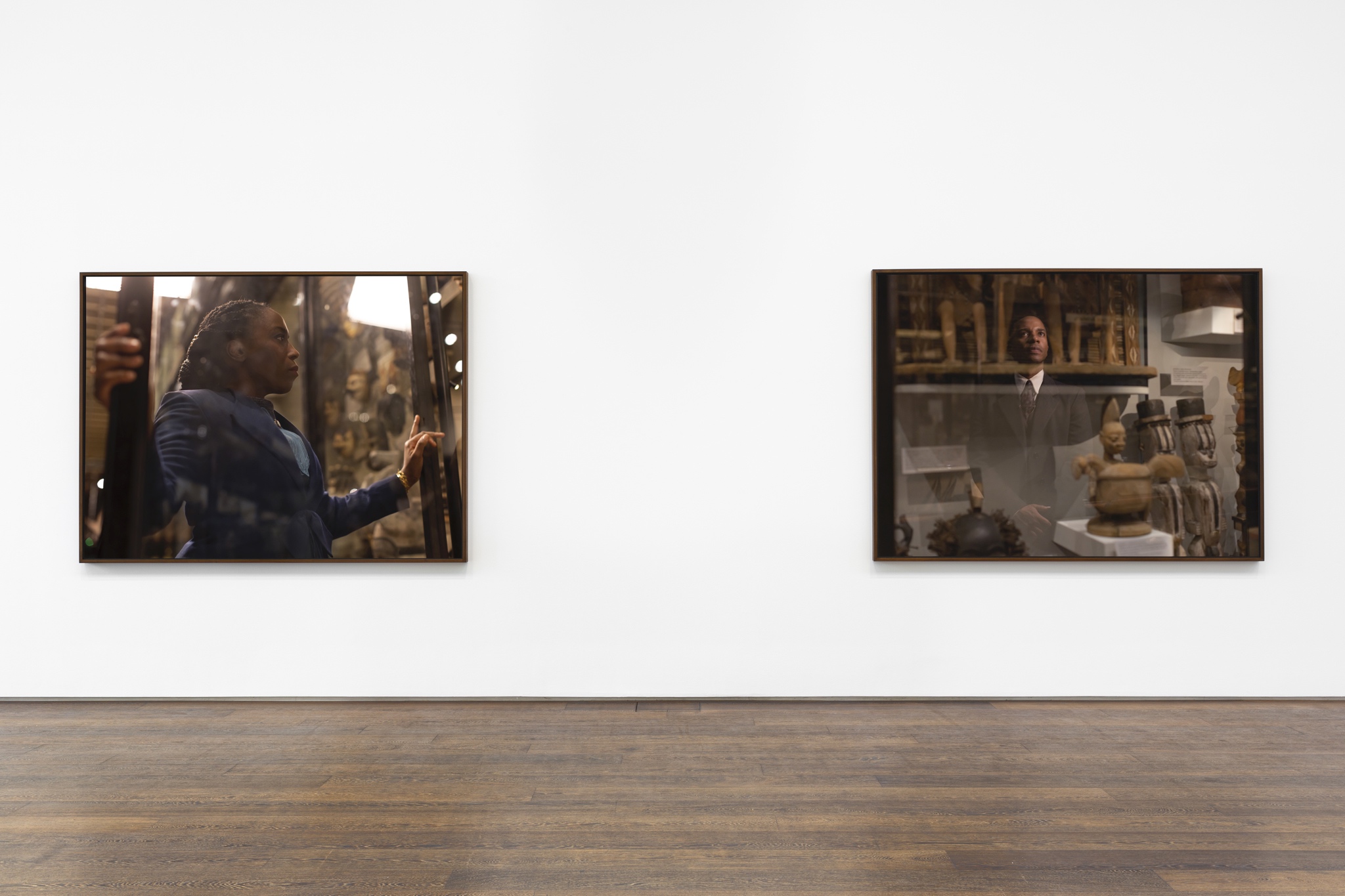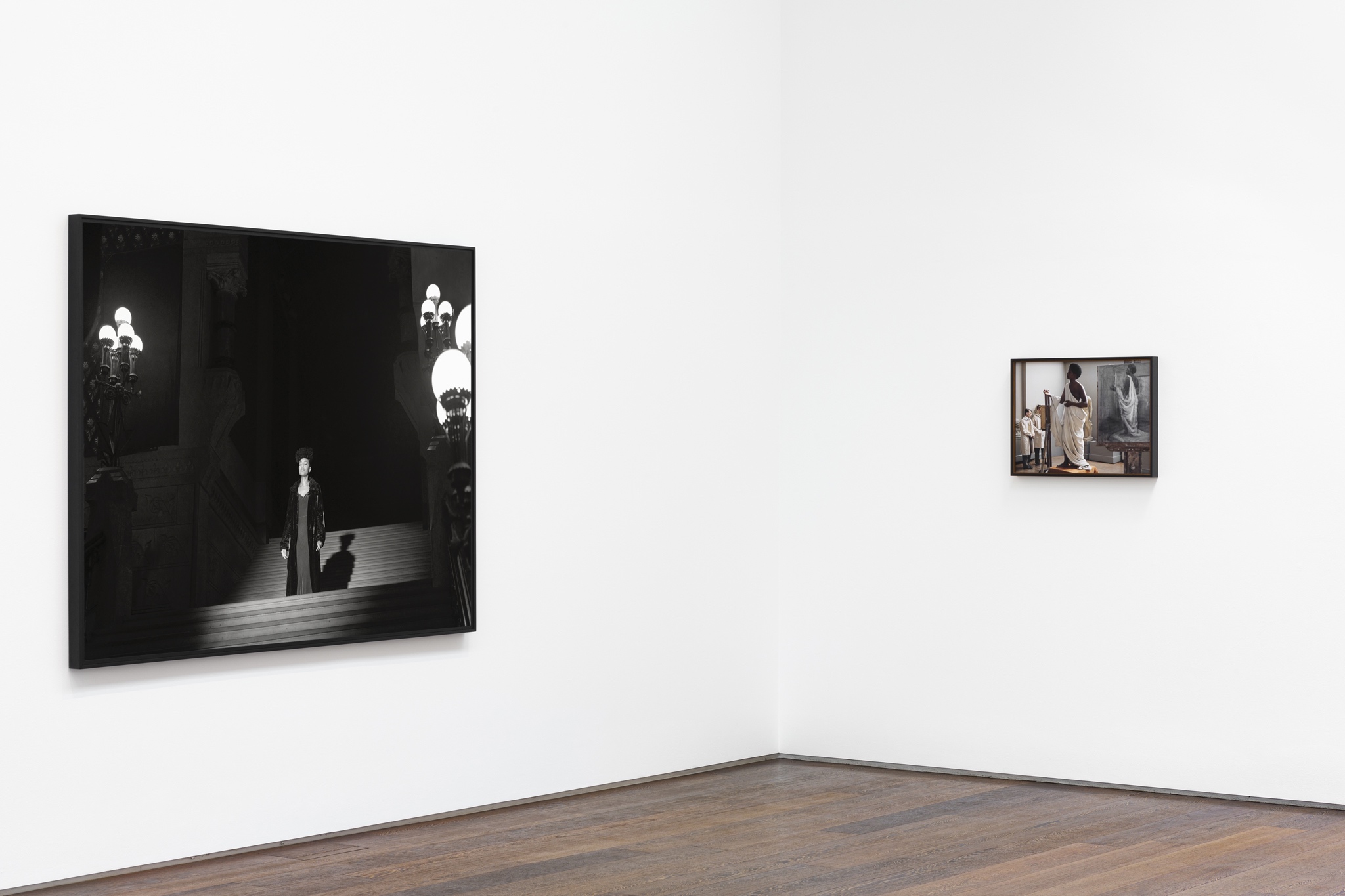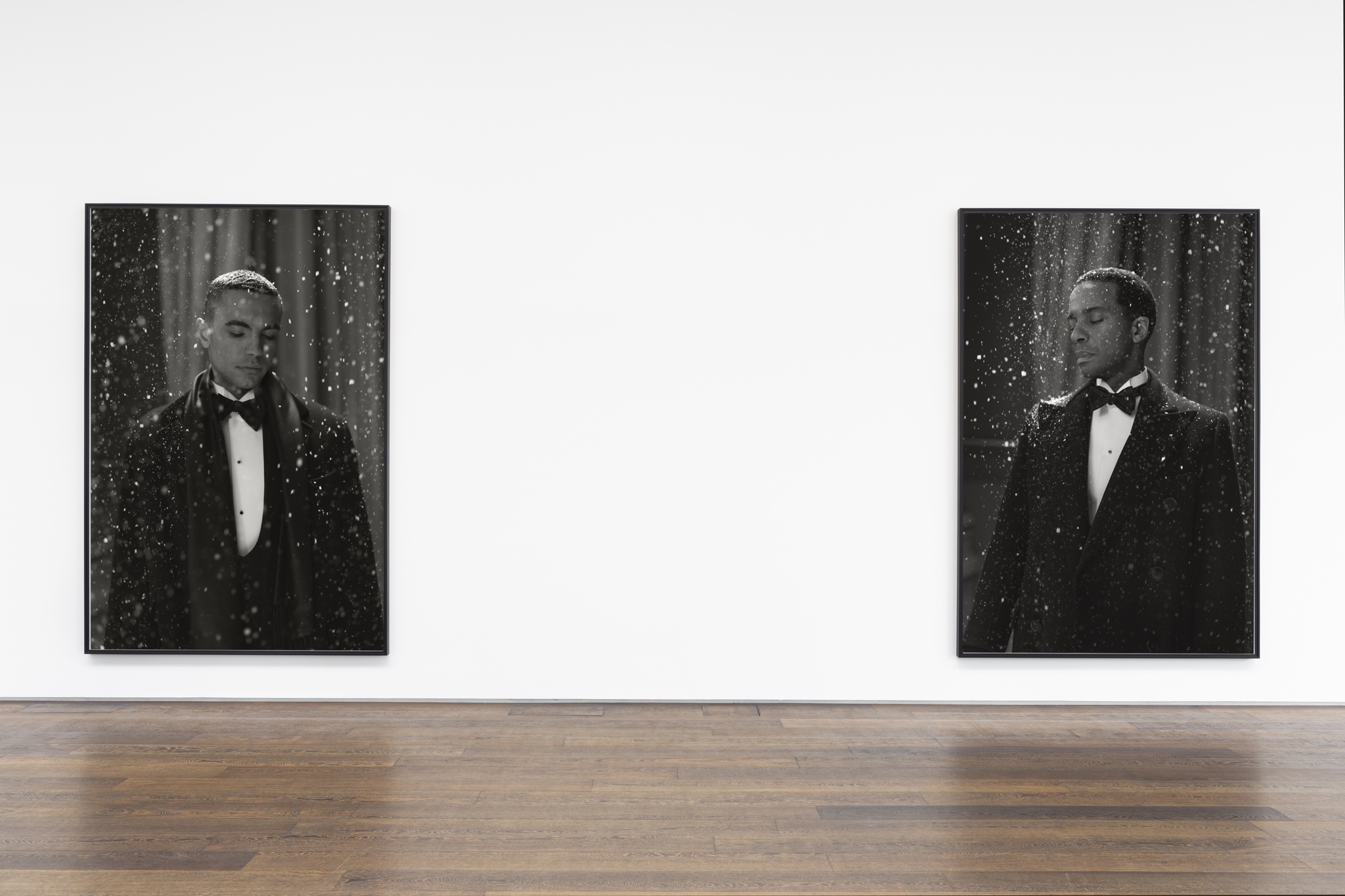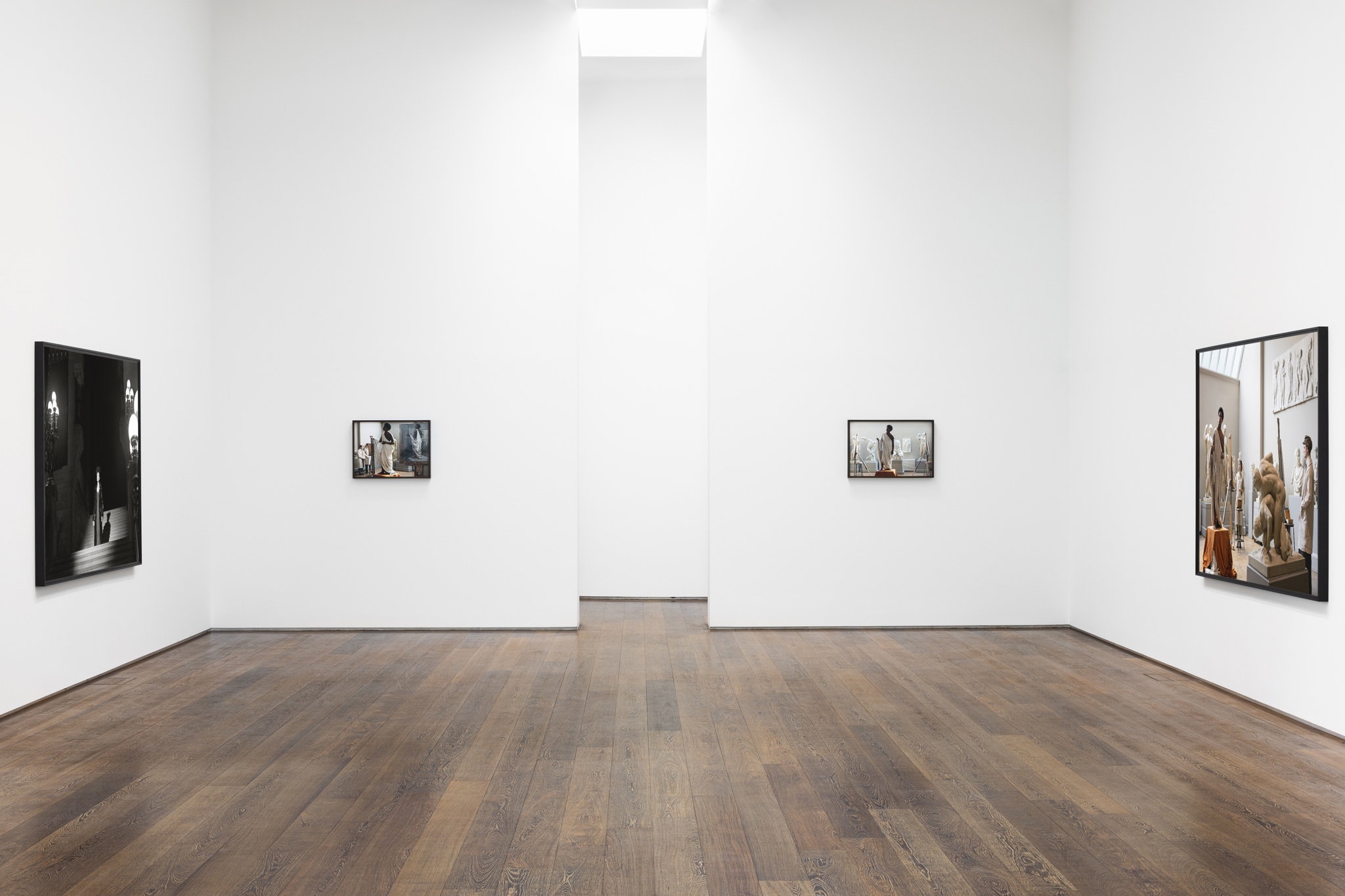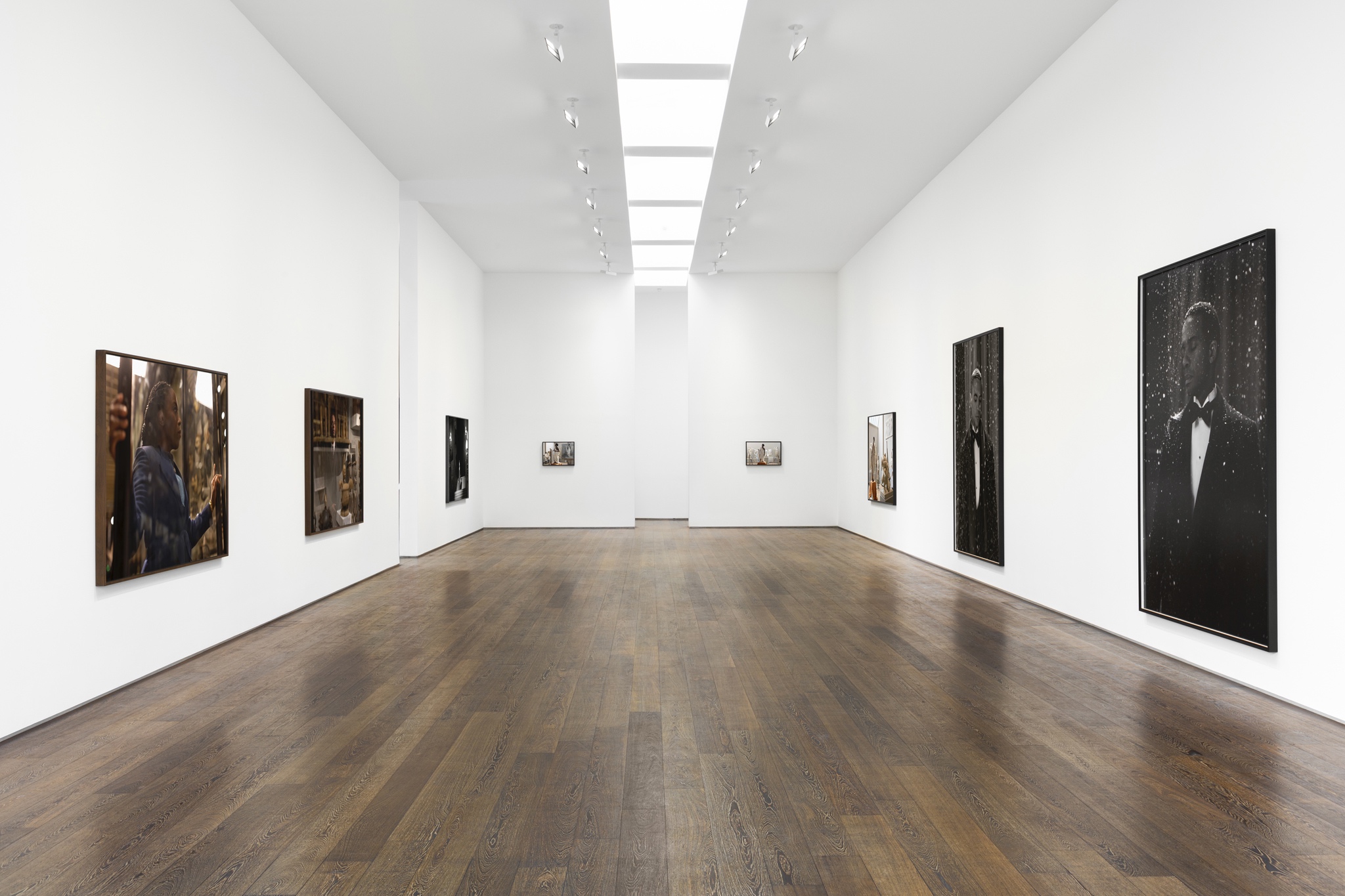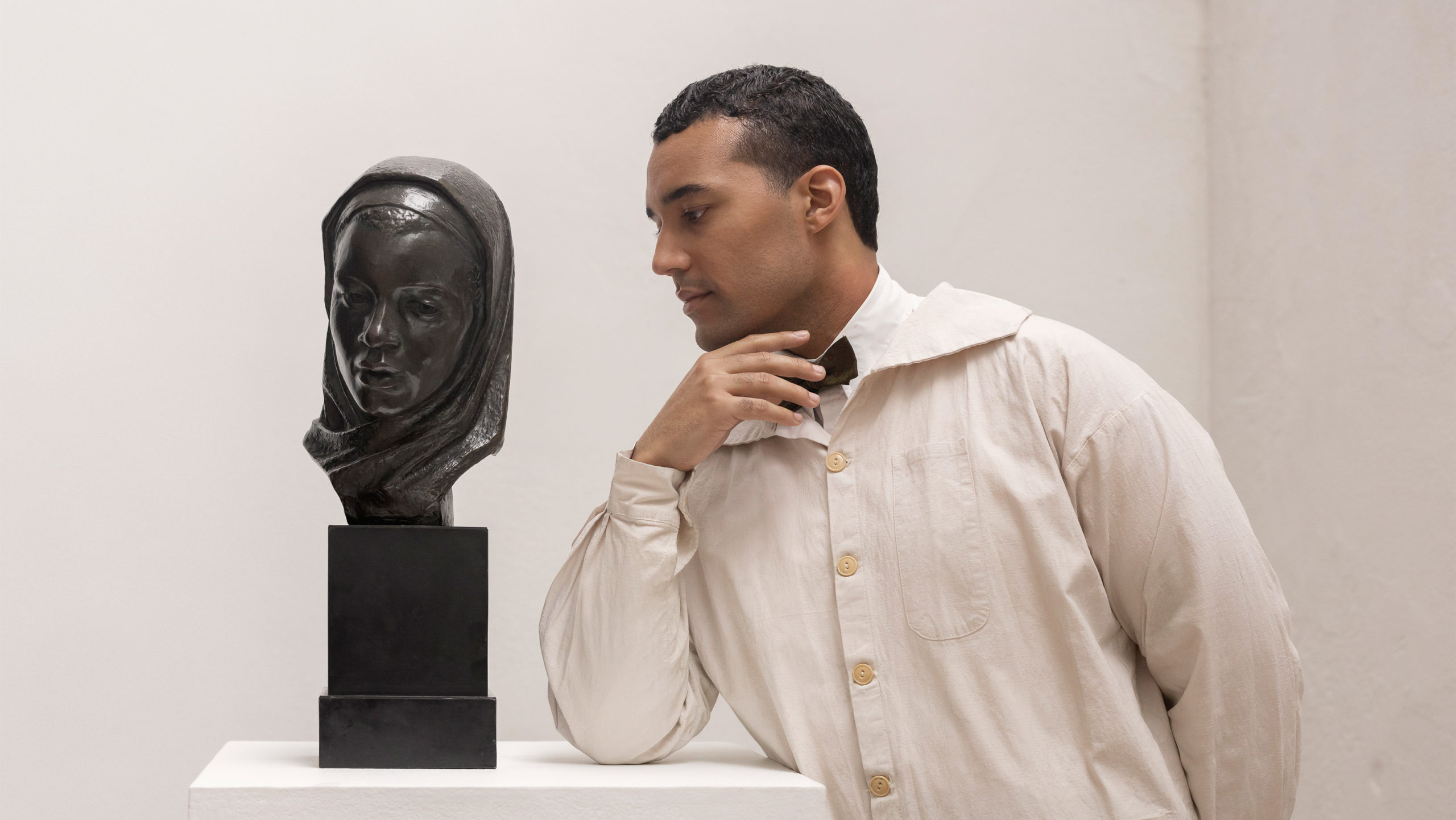
Isaac Julien: Once Again… (Statues Never Die) – Photographs
Exhibition 2 May–4 June 2023
Tuesday–Saturday: 10am–6pm
Special opening for London Gallery Weekend: Sunday 4 June: 10am–5pm
16 Wharf Road, London N1 7RW
Isaac Julien’s latest work Once Again… (Statues Never Die) is the focus of this exhibition of newly conceived photographic works.
Once Again… (Statues Never Die) is an immersive five-screen installation by artist and filmmaker Sir Isaac Julien. Commissioned by the Barnes Foundation in celebration of its centenary, the work explores the relationship between Dr. Albert C. Barnes, who was an early US collector and exhibitor of African material culture, and the famed philosopher and cultural critic Alain Locke, known as the ‘Father of the Harlem Renaissance’.
Aspects of the film are expanded upon in Julien’s new series of photographic works.
Selected works in the series are featured below.
This new photographic series is inspired by Isaac Julien’s extensive research into the work and critical writing of Alain Locke (1885–1954), leader of the Harlem Renaissance, and his relationship to Albert C. Barnes, the philanthropist, pioneering art collector and founder of the Barnes Foundation, Philadelphia.
The exhibition comprises photographic artworks (all dated 2022) which honour Locke’s contribution to the arts while also inviting critical conversations around the African material culture that influenced the Black cultural movement. The writings of Alain Locke and Albert C. Barnes on the meaning and value of African material culture were reproduced in Harlem Renaissance periodicals of the 1920s including Opportunity, Survey Graphic, and The Crisis.
The motif of weather and the elements of snow and winter permeate this series of photographs. They reference Christina Sharpe’s concept of weather as ‘the totality of our environments’ and bell hooks’ text Winter, in which she writes, ‘we emerge out of the snowy mist, shadowy figures moving into clear light; in clear light… we see one another. One mystery is solved: we are the shadowy figures… looking for the door to transgressive culture that will let us in.’
‘Isaac’s work has been and continues to be an engagement with the power of becoming free – of walking away from received imposed thoughts and images and walking toward ideas, thoughts, and images emerging from a commitment to an artistic aesthetic that requires utter devotion to seeing beauty as the essence of making any art. It is his profound belief that engaging beauty and cultivating our capacity to experience the beautiful is a necessary act of political resistance,’ writes bell hooks in Winter. After her death in December 2021, Julien went back to hooks’ text written for his autobiography Riot and excerpted parts of it for his immersive five-screen moving-image installation Once Again… (Statues Never Die) and dedicated this work to bell.
In Julien’s work, the totality of the artistic environment includes his photographic artworks as well as his moving-image installations, and in the case of Once Again… (Statues Never Die) those atmospheres are created between the political reality of racism and class discrimination, and the use of ‘critical fabulation,’ a speculative storytelling inhabiting what hooks describes as ‘the mystical diasporic dream-space.’
Isaac 1 (Diasporic Dream-Space)
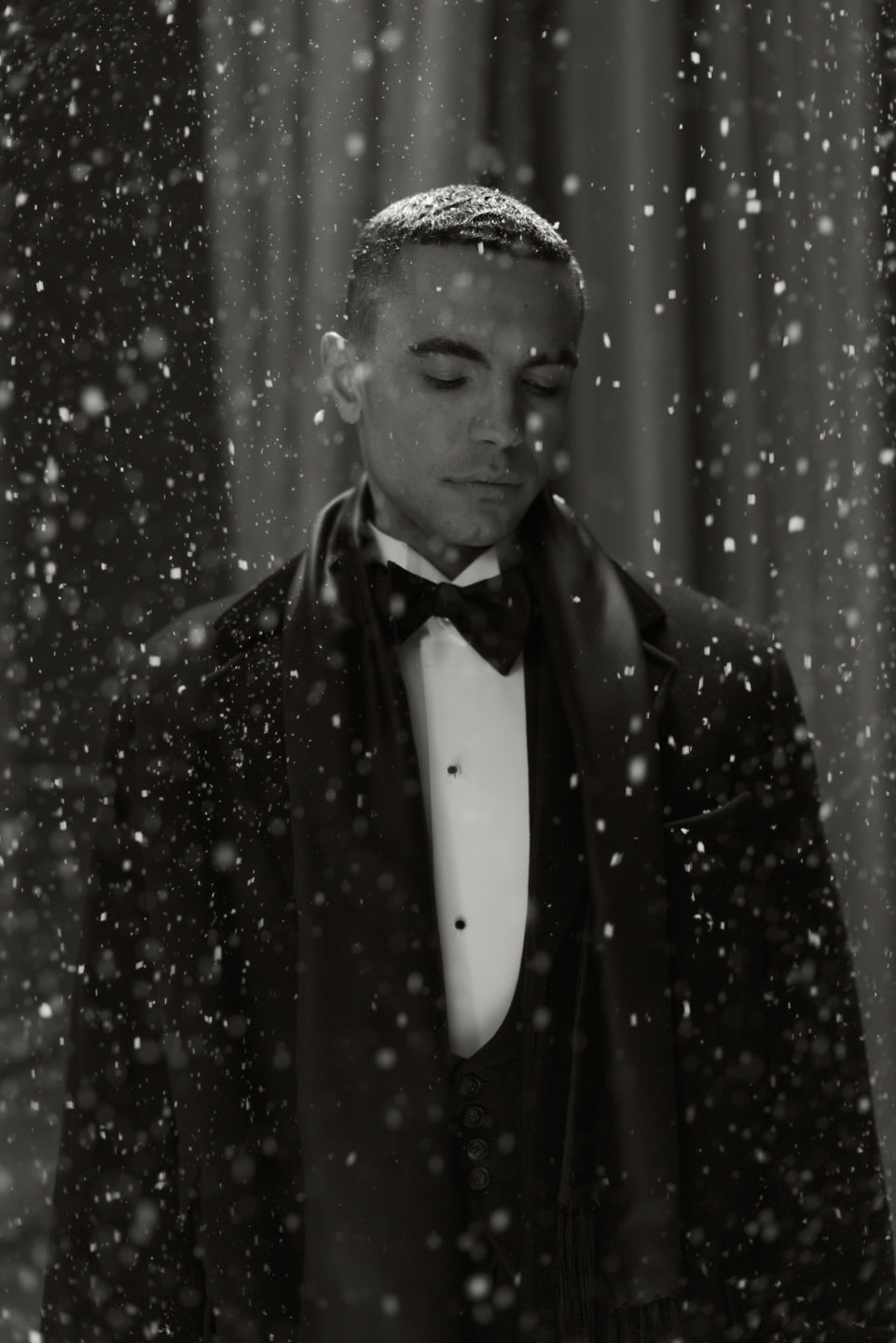
Inkjet print on Canson Platine Fibre Rag
270 x 180 cm
106 1/4 x 70 7/8 in
Edition of 6 plus 2 artist's proofs
Isaac Julien, Diasporic Dream-Space No. 2 (Once Again… Statues Never Die), 2022
More info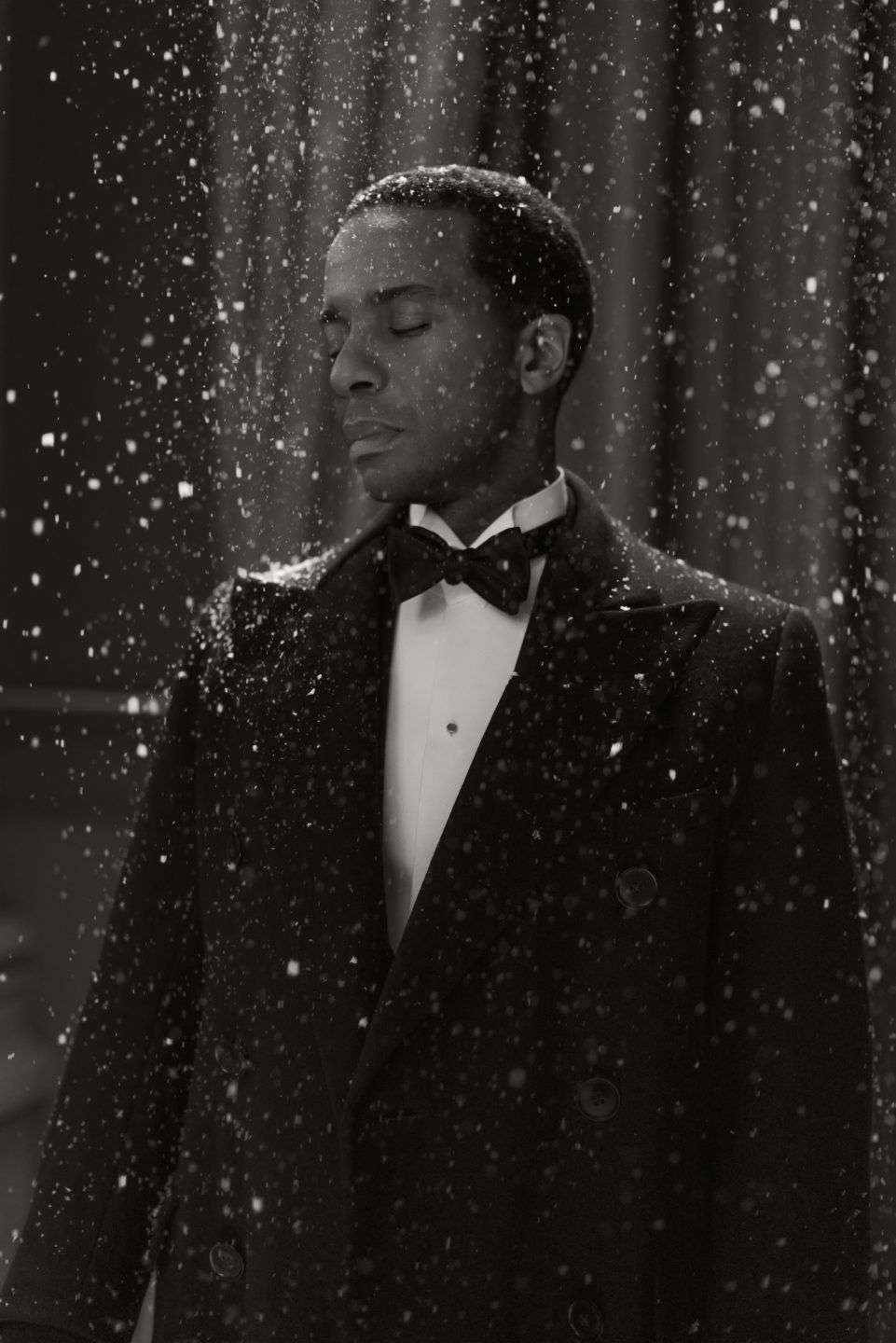
Inkjet print on Canson Platine Fibre Rag
270 x 180 cm
106 1/4 x 70 7/8 in
Edition of 6 plus 2 artist's proofs
Isaac Julien, Freedom / Diasporic Dream-Space No. 1 (Once Again… Statues Never Die), 2022
More info‘These images encapsulate this diasporic dream-space; they are about the imaginative possibilities.’ — Isaac Julien
The portraits of André Holland as Alain Locke and Alex Part as his alter ego in Diasporic Dream-Space No. 1 and Diasporic Dream-Space No. 2 create a stunning visual diptych of two figures suspended in time under the falling snow, and this changing weather is where, as bell hooks writes, ‘a culture of infinite possibility is ready to receive us. This is artistic freedom as pure and unsullied as falling snow – as snow so deep it remains undisturbed – a whiteout.’ These images encapsulate this diasporic dream-space; they are about the imaginative possibilities.
These and other photographic artworks contain visual references to Julien’s seminal film Looking for Langston, 1989, whose pioneering theme of the queer subculture of 1920s Harlem is further explored in Once Again… (Statues Never Die) through its reflection on the relationship between Alain Locke and the sculptor Richmond Barthé. For this, Barthé’s sculptures were staged at the Pennsylvania Academy of the Fine Arts (PAFA).
Isaac 2 (Iolaus)
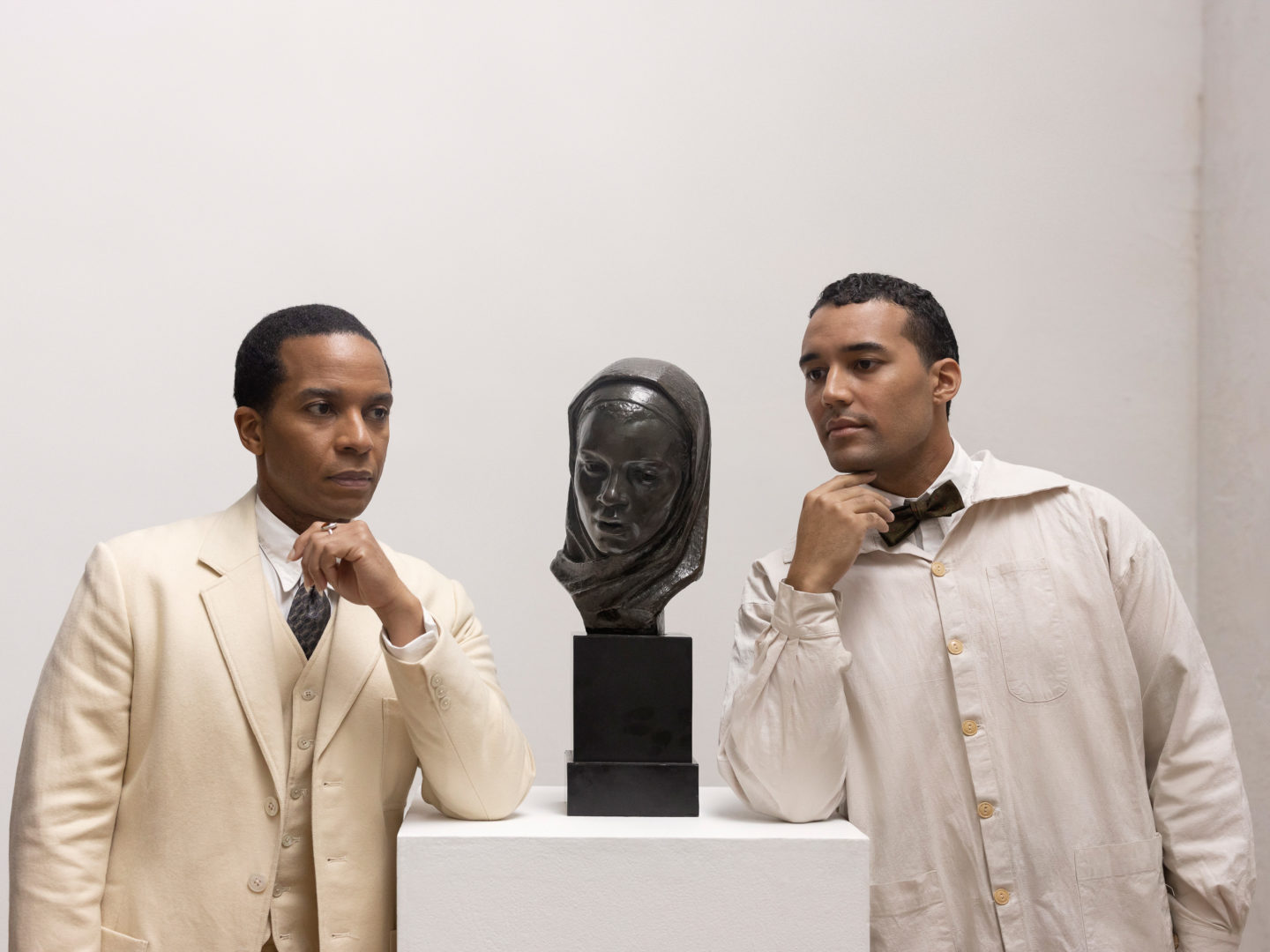
Inkjet print on Canson Platine Fibre Rag
150 x 200 cm
59 x 78 3/4 in
Edition of 6 plus 2 artist's proofs
Isaac Julien, Iolaus / In the Life (Once Again… Statues Never Die), 2022
More infoIn his research for Looking for Langston, Julien came across an archival image of Richmond Barthé and Alain Locke in an art gallery. Richmond Barthé (1901–1989) was a well-known African American sculptor who established his first studio in Harlem in 1930 and had a successful career throughout his lifetime.
Iolaus / In the Life alludes to a colloquialism ‘in the life’ – a Black gay term from that period (‘you’re in the life’) – and is a reference to Locke’s and Barthé’s romantic engagement as occasional lovers. Julien refers to these photographs as ‘echoes’. Iolaus is Hercules’ nephew famed for being one of the Argonauts and is also the name Barthé gave to his house when he relocated to Jamaica, having become disillusioned with New York City, fame and the art world.
Isaac 3 (Night Rain)
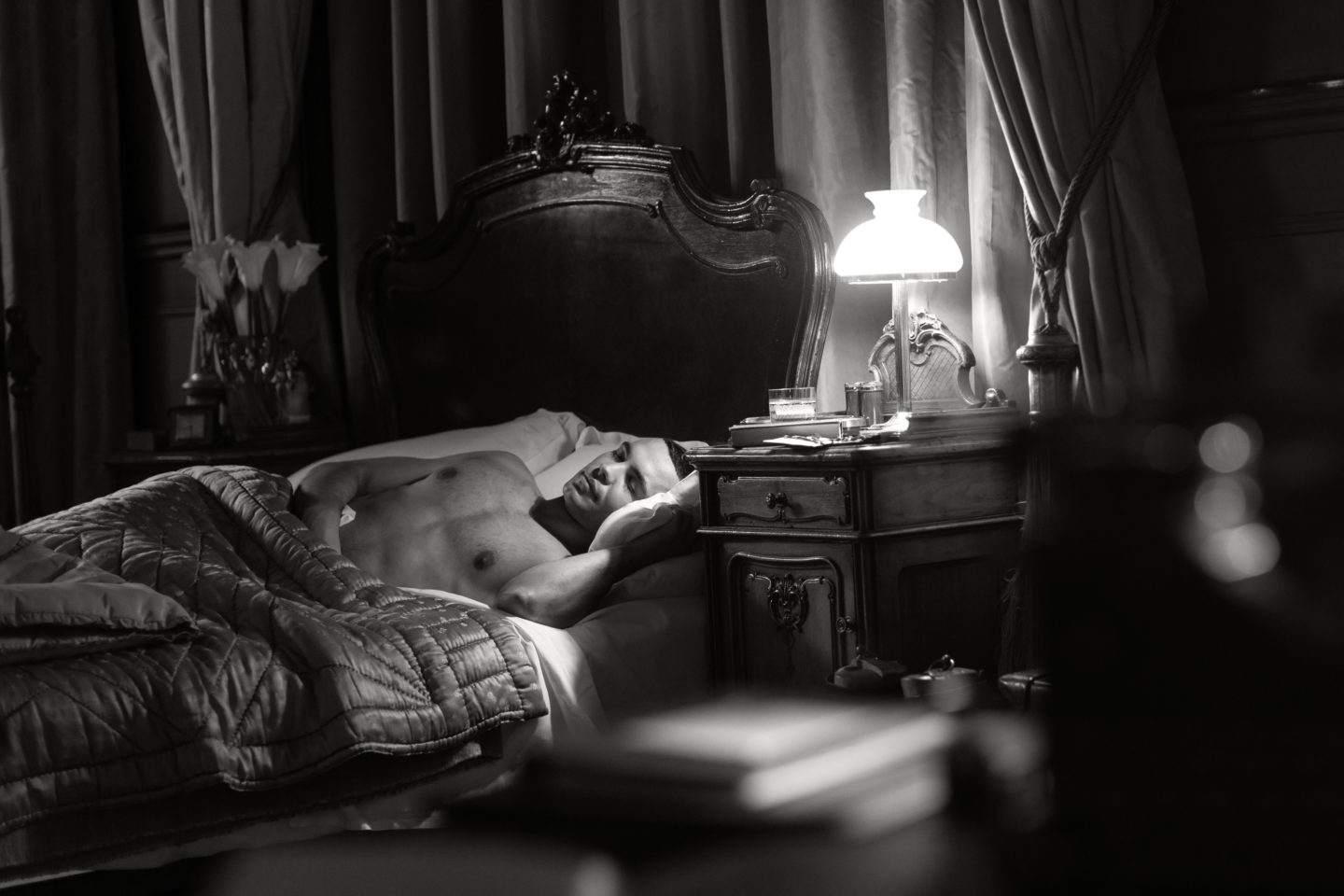
Inkjet print on Canson Platine Fibre Rag
150 x 225 cm
59 x 88 5/8 in
Edition of 6 plus 2 artist's proofs
Isaac Julien, Night Rain (Once Again… Statues Never Die), 2022
More infoDuality of existence – of being simultaneously in life and in a dream – is a theme of works such as Night Rain, which take us back to the weather, to the environment that Langston Hughes inhabited. His poem Harlem (also known as A Dream Deferred) was first published in 1951 in Hughes’ book Montage of a Dream Deferred.
Isaac 3a (Sonata in Red)
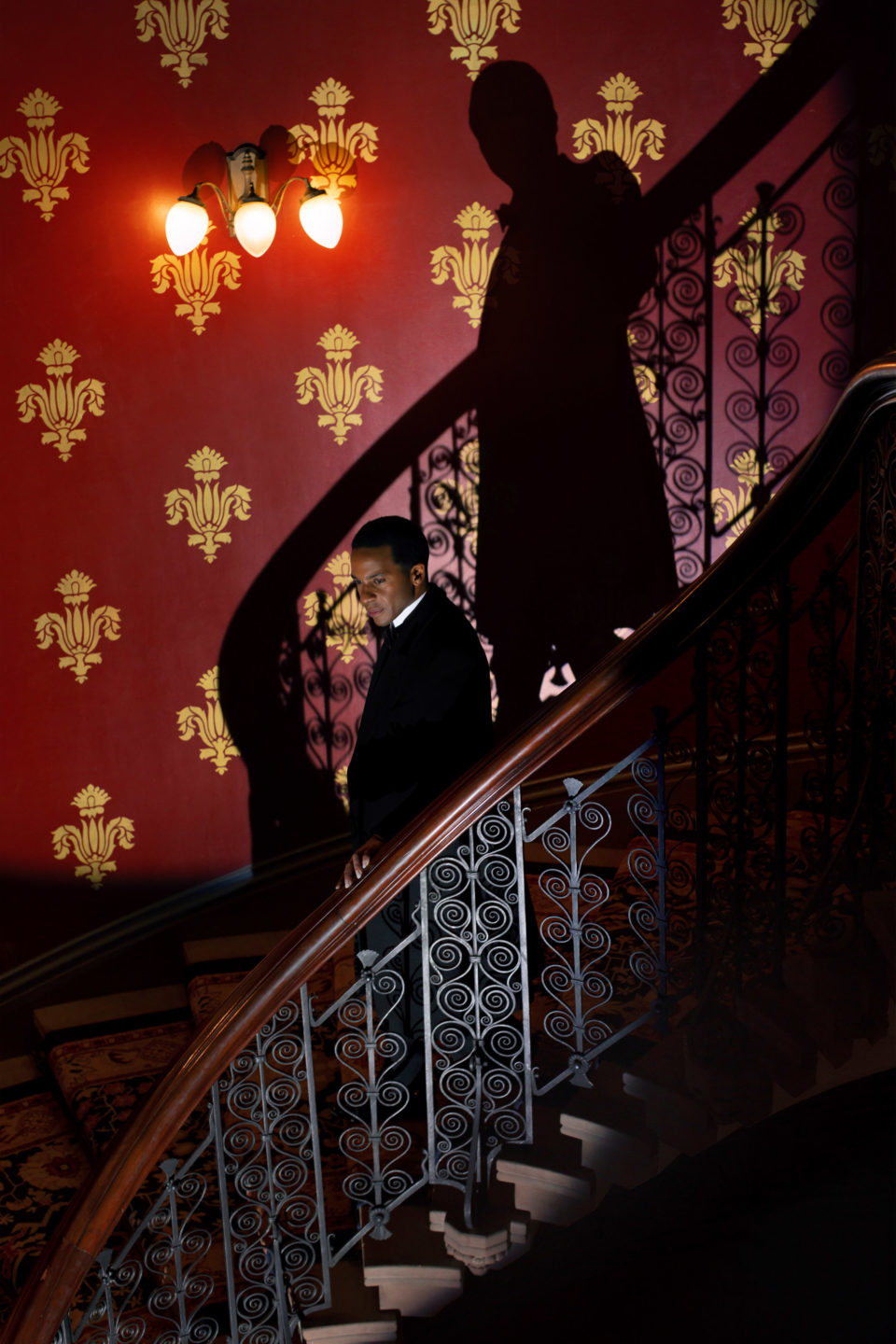
Inkjet print on Hahnemühle Photo Rag Ultrasmooth
225 x 150 cm
88 5/8 x 59 in
Edition of 6 plus 2 artist's proofs
Isaac Julien, Sonata in Red (Once Again… Statues Never Die), 2022
More infoMusic and rhythm are alluded to in a number of the works in the series. Julien thinks of the melody behind Sonata in Red as being a song of a late hour in 1920s Harlem, while André Holland as Alain Locke lays his shadow on the wall behind him as he descends the stairs to meet his lover in the notes of the night, a direct homage to Julien’s 1989 film Looking for Langston; in this work he returns to the site of that film.
Isaac 4 (Statues Never Die)
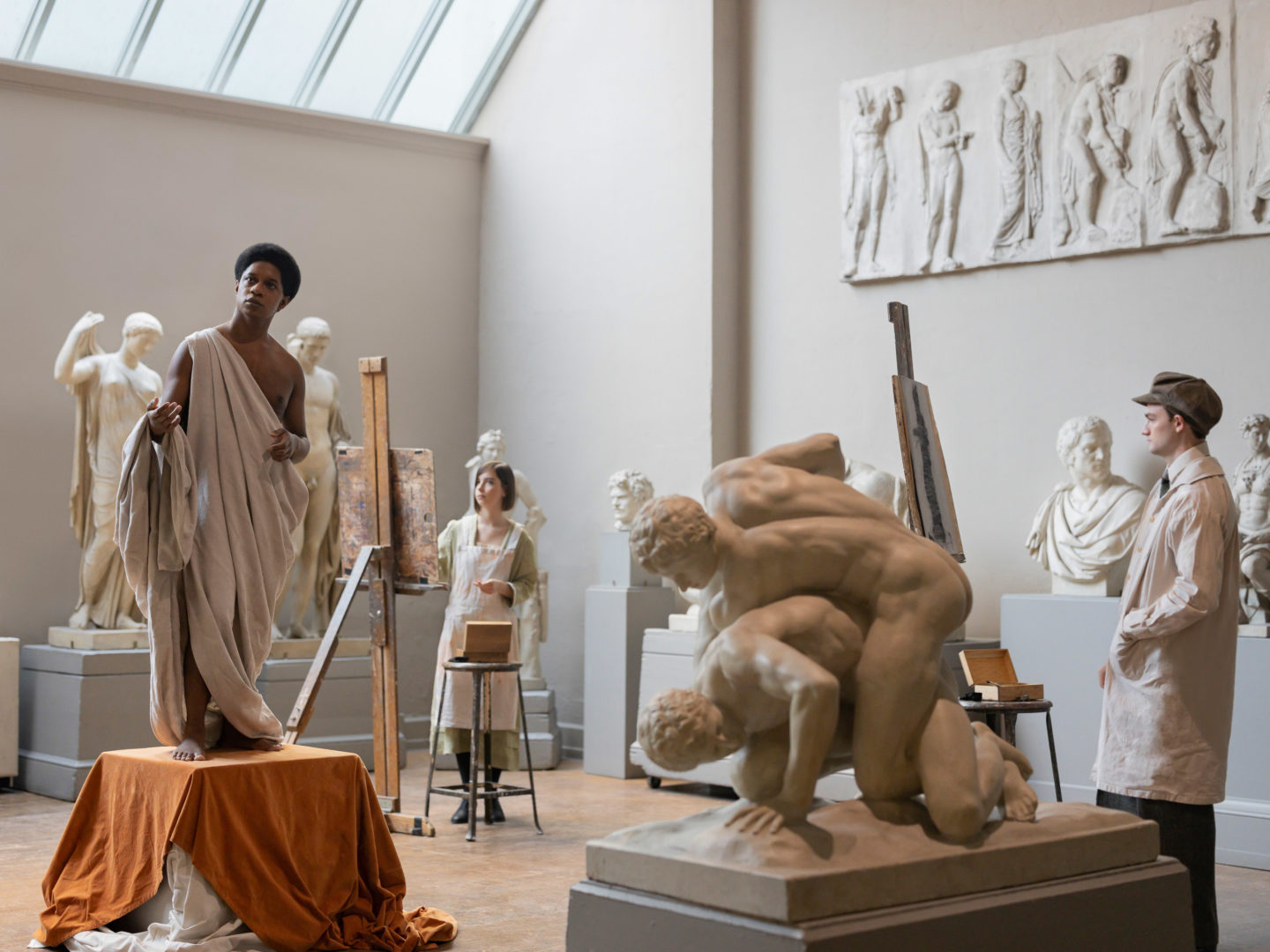
Inkjet print on Canson Platine Fibre Rag
150 x 200 cm
59 x 78 3/4 in
Edition of 6 plus 2 artist's proofs
Isaac Julien, Statues Never Die (Once Again… Statues Never Die), 2022
More infoWorks such as Statues Never Die contain references to Black Athena history, the African presence in the ancient civilisations, and to Albert Barnes’s interest in art collecting. These images interweave Grecian and Roman idioms with classical Nubian sculpture. They speak of the importance of the spaces between when portraying objects and people in still life and sculpture. The figure is becoming a statue, becoming an object – also becoming a classical mythological hero. The works are a testimony to the plurality of media in the history of Black art and in Julien’s work, in painting and sculpture, film and photography.
Isaac 5 (3 x small works)
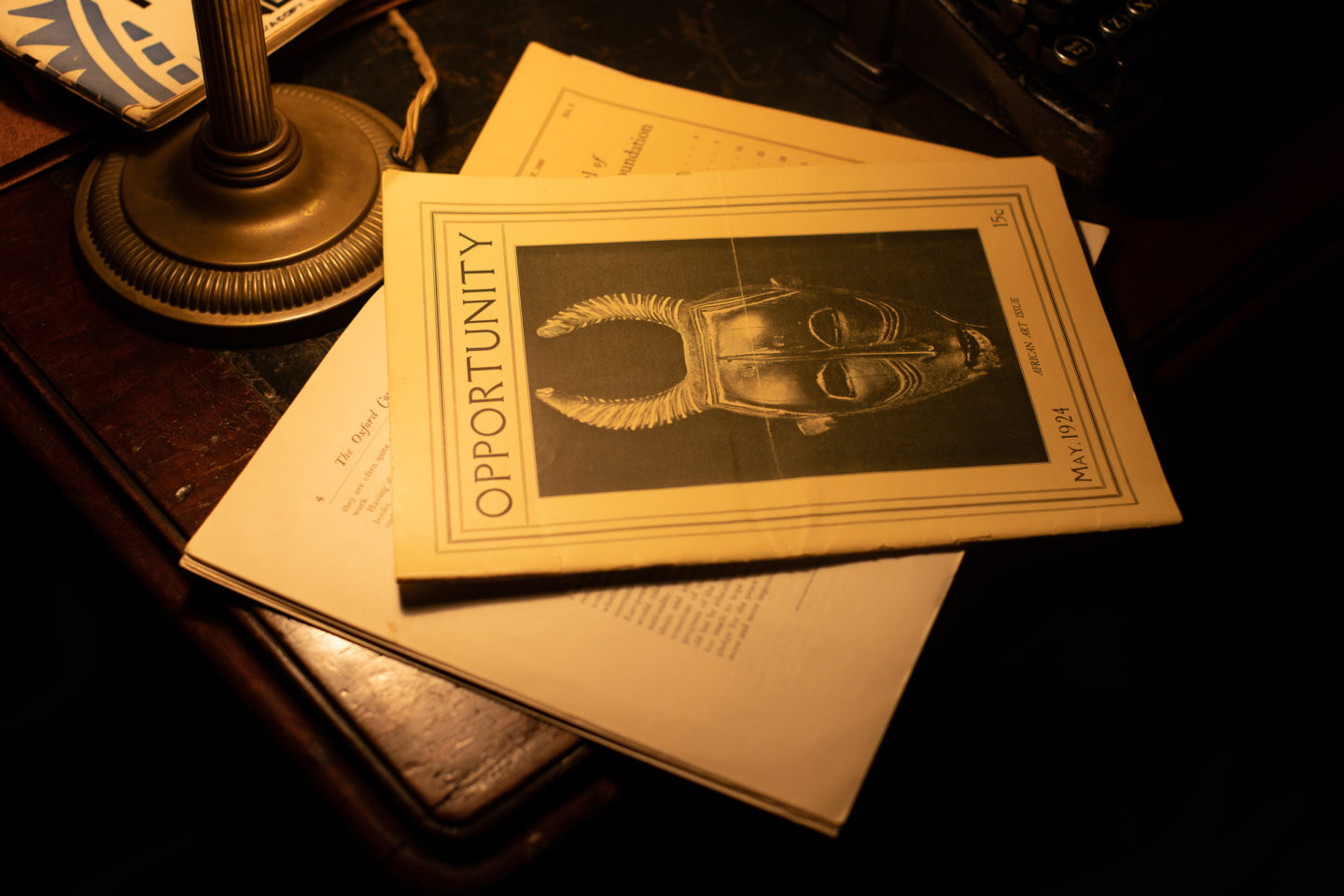
Inkjet print on Hahnemühle Photo Rag Ultrasmooth
50 x 75 cm
19 3/4 x 29 1/2 in
Edition of 6 plus 2 artist's proofs
Isaac Julien, Mask (Once Again… Statues Never Die), 2022
More info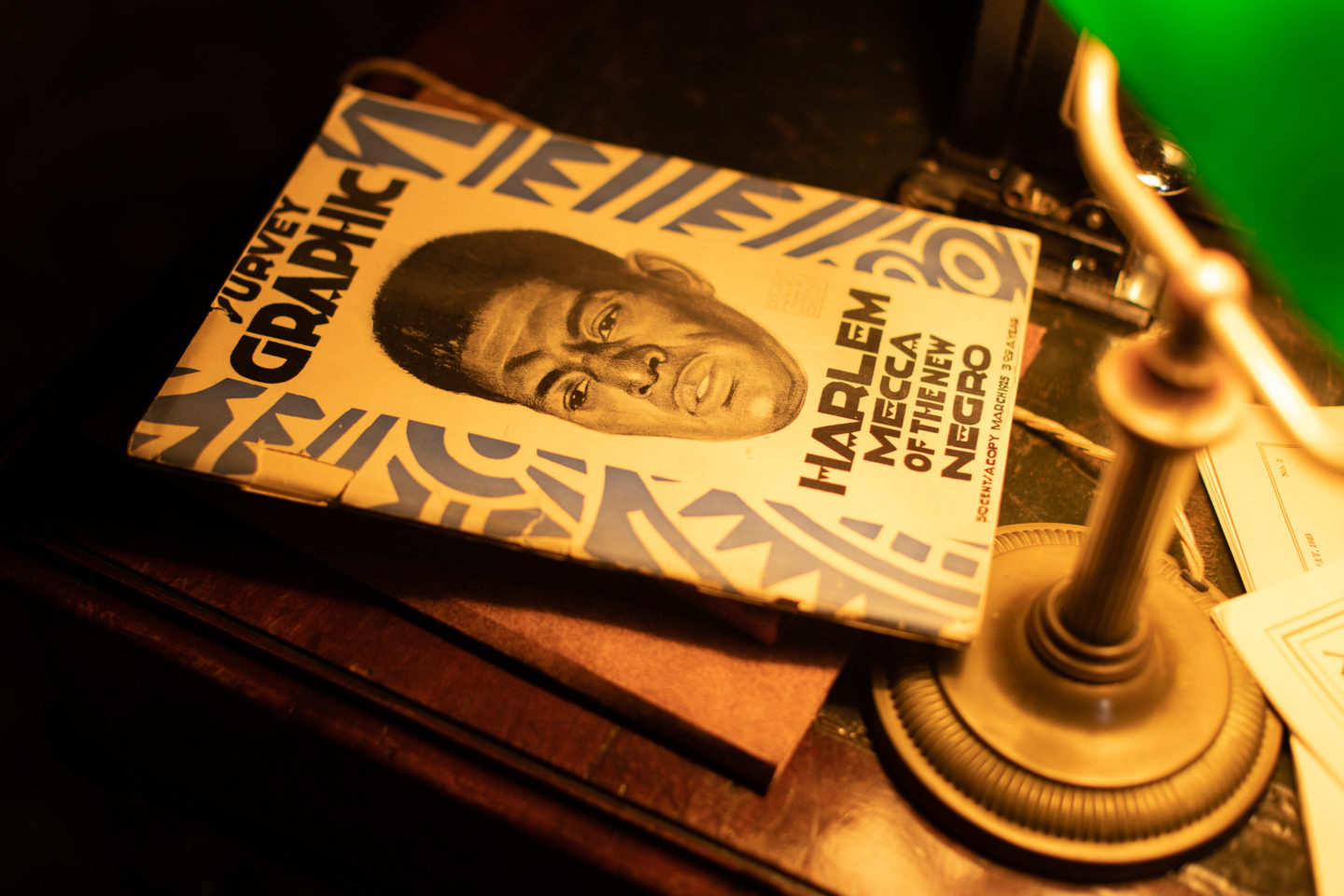
Inkjet print on Hahnemühle Photo Rag Ultrasmooth
50 x 75 cm
19 3/4 x 29 1/2 in
Edition of 6 plus 2 artist's proofs
Isaac Julien, Harlem Mecca (Once Again… Statues Never Die), 2022
More info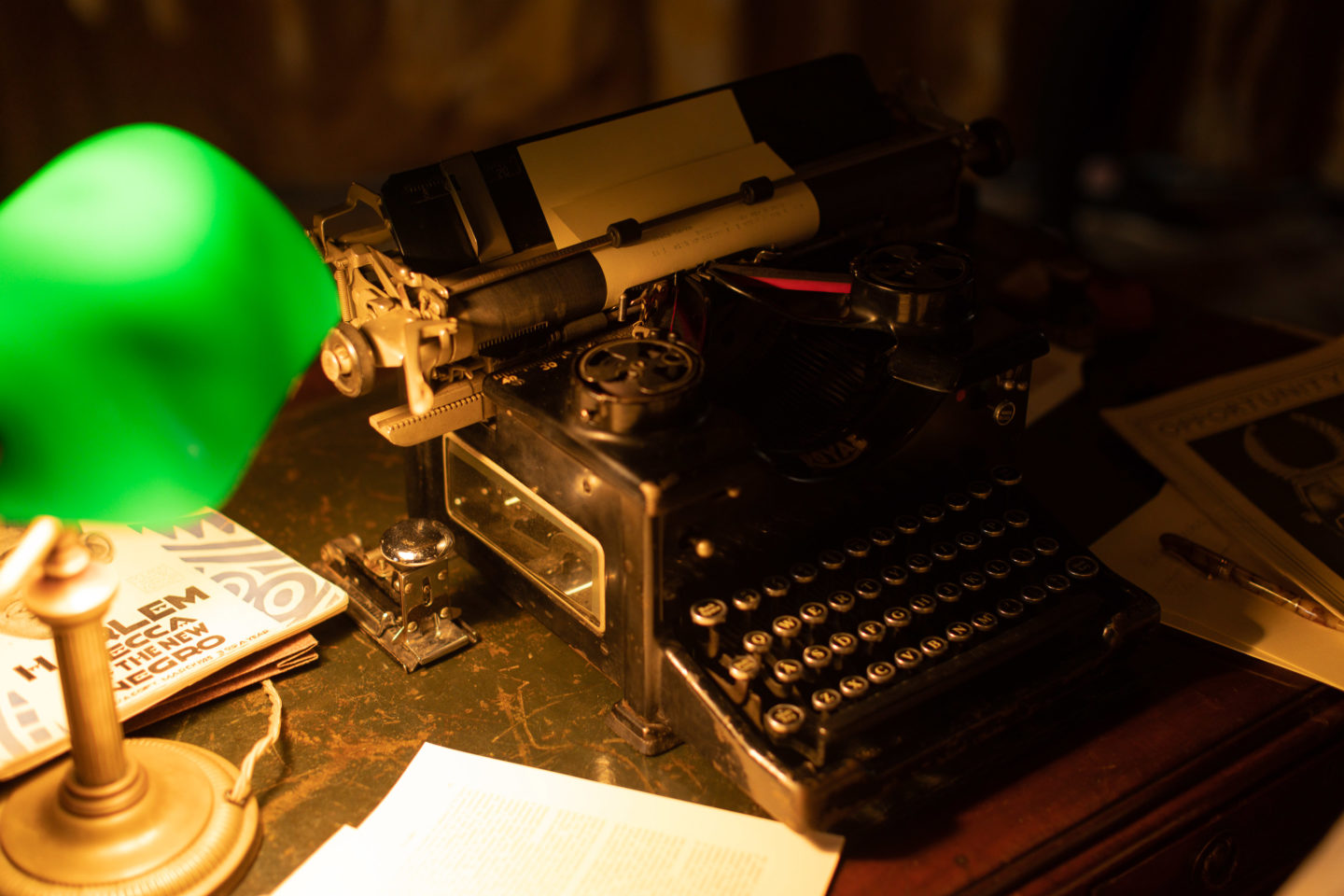
Inkjet print on Hahnemühle Photo Rag Ultrasmooth
50 x 75 cm
19 3/4 x 29 1/2 in
Edition of 6 plus 2 artist's proofs
Isaac Julien, The Conversation (Once Again… Statues Never Die), 2022
More infoA series of photographic still life works is dedicated to the archival periodicals of the 1920s. Mask is a visual reference to The African Art Issue of the Opportunity magazine from May 1924 with A Note on African Art by Alain Locke followed by The Temple by Albert C. Barnes. This issue also featured articles by Claude McKay, Paul Guillaume and a poem by Langston Hughes.
The visual motif of the photograph Harlem Mecca is the special edition of Survey Graphic magazine entitled Harlem, Mecca of the New Negro. Published in March 1925, the same year as Alain Locke’s influential anthology The New Negro, the periodical’s first article Enter the New Negro introduces the theme of the ‘Old’ versus the ‘New Negro’, a motif that Locke explores in The New Negro, the definitive text of the Harlem Renaissance. The cover featured the renowned tenor and composer Roland Hayes (1887–1977) in a portrait by Winold Reiss (1886–1953), who also created a portrait of Locke in the same year.
In The Conversation, standing between a copy of Harlem, Mecca… and Opportunity on an antique table in the middle of a room, is a typewriter with a green lamp illuminating the sheet of paper tucked into it, which shows the beginning of a conversation, a dialogue, or perhaps a love letter. It’s a poetic visual reference to the correspondence between Locke and Barnes; to all the Black literary figures of the 1920s who started writing the first pages of their prominent books under just such a yellow glow, but also to the intimate and often secret desire; to letters never sent and passion never fulfilled.
Isaac 6 (Orisa’s Return)
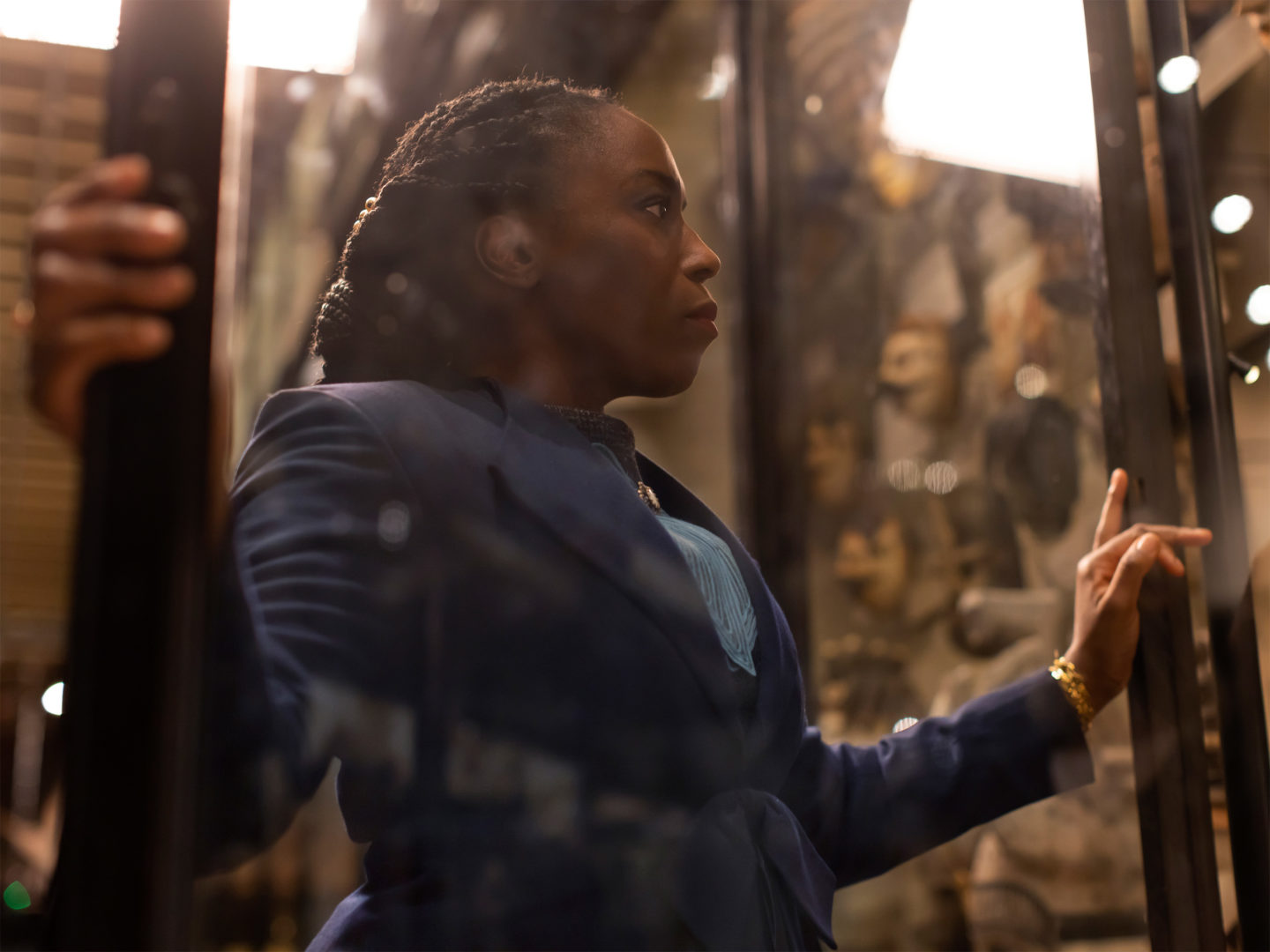
Inkjet print on Canson Platine Fibre Rag
150 x 200 cm
59 x 78 3/4 in
Edition of 6 plus 2 artist's proofs
Isaac Julien, Orisa’s Return (Once Again… Statues Never Die), 2022
More infoOrisa’s Return is inspired by the writings of the novelist, playwright and Nobel Laureate Wole Soyinka. Orisa is an African spirit who has a key role in the Yoruba religion. In his book Beyond Aesthetics, Soyinka looks at the politics and aesthetics of collecting African art. The figure in Orisa’s Return symbolises a curator, a keeper, someone with a relationship to the spiritual objects. The work is also about the alienation effect, the clinical gaze, as all of the objects that have been taken are labelled and either displayed in glass vitrines or kept in storage.
Isaac 7 (once again)
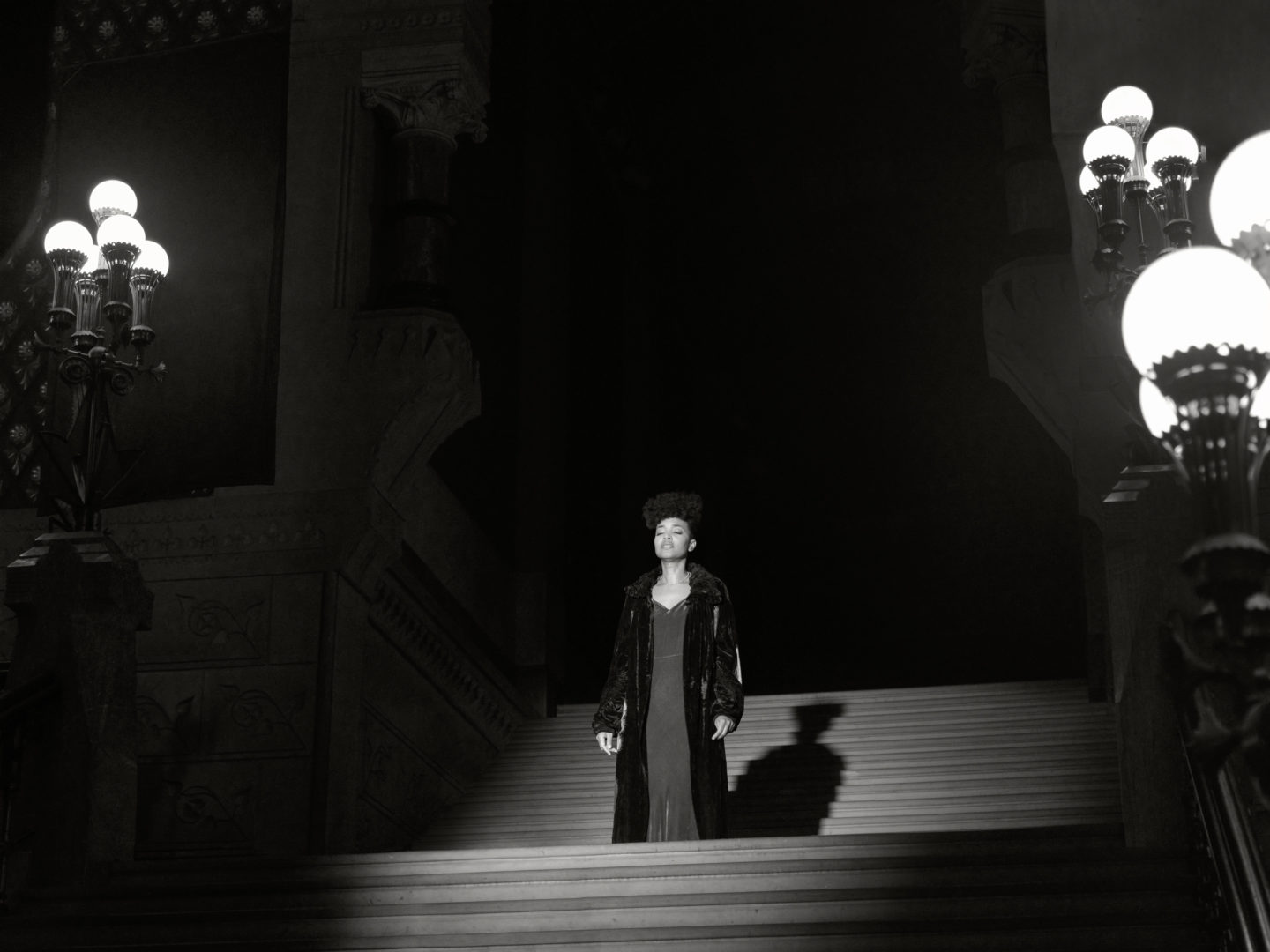
Inkjet print on Canson Platine Fibre Rag
150 x 200cm
Edition of 6 plus 2 artist's proofs
Isaac Julien, Once Again (Once Again… Statues Never Die), 2022
More info‘The camera holds the moment of a calm triumph, of introspection and haunting memory, as Alice Smith embodies the beautiful as a necessary act of political resistance and lets all worldly things go.’ — Isaac Julien
‘Once again, I defend my open heart, no question. My old ways, bad old days pass me by like the weather,’ the celebrated American vocalist Alice Smith sings in the piece written and composed for Julien’s five-screen moving image installation Once Again… (Statues Never Die). Smith is the central motif of the photographic artwork Once Again. Time is seen here as repetition; as a revisit, a return. In the photograph, the camera holds a moment of a calm triumph, of introspection and haunting memory, as Alice Smith embodies the beautiful as a necessary act of political resistance and lets all worldly things go.
About the artist
Born in 1960, Isaac Julien lives and works in London and Santa Cruz, California. He has been making films and producing film installations for over forty years, including Once Again… (Statues Never Die) (2022), Lina Bo Bardi – A Marvellous Entanglement (2019), Lessons of the Hour – Frederick Douglass (2019), Stones Against Diamonds (2015), PLAYTIME (2014), Ten Thousand Waves (2010), Western Union: Small Boats (2007), Fantôme Afrique (2005), True North (2004), Baltimore (2003), Paradise Omeros (2002), Vagabondia (2000), and Long Road to Mazatlan (1999).
Opening at Tate Britain in April 2023, Isaac Julien: What Freedom Is To Me reveals the scope of Julien’s pioneering work in film and installation from the early 1980s through to the present day. This major exhibition is on view 26 April–20 August 2023. Other current and recent international solo and group exhibitions include: Isaac Julien: PLAYTIME, PalaisPopulaire, Germany; Isaac Julien: Lina Bo Bardi – A Marvellous Entanglement, Philadelphia Museum of Art, Philadelphia, USA (2023); Isaac Julien: Once Again… (Statues Never Die), Barnes Foundation, Philadelphia; Isaac Julien: Lessons of the Hour – Frederick Douglas, Virginia Museum of Fine Arts, USA; Isaac Julien, Goslar Kaiserring, Mönchehaus Museum, Goslar, Germany; Details of Regeneration: Black Cinema 1898 – 1971, Academy Museum, Los Angeles, CA, USA; Life Between Islands: Caribbean-British Art 1950s-Now, Tate Britain, London, UK (2022); Isaac Julien: Lessons of the Hour, Smith College Museum of Art, Northampton, USA; Isaac Julien: Lessons of the Hour, McEvoy Foundation for the Arts, San Francisco (2021); Isaac Julien: Lina Bo Bardi. A Marvellous Entanglement, MAXXI, Rome, Italy (2020) touring to Bechtler Museum of Modern Art, Charlotte NC, USA; Galeria Helga de Alvear, Madrid, Spain; Roslyn Oxley9 Gallery, Sydney, Australia (2021-2022); Isaac Julien: Western Union: Small Boats, Neuberger Museum, New York; Masculinities: Liberation through Photography, Barbican Art Gallery, London, travelling to Martin-Gropius-Bau, Berlin, among others (2020); Baltimore at the Baltimore Museum of Art (2019-2020); Isaac Julien: Frederick Douglass: Lessons of the Hour, SCAD Museum of Art, Savannah (2019; Looking for Langston at Tate Britain (2019); Playtime at LACMA (2019); Black Refractions: Highlights from the Studio Museum in Harlem at the Gibbes Museum (2019). Also in 2019, Julien’s Playtime was featured as part of Ruby City’s inaugural programme.
Previously, Julien has had solo exhibitions at venues including ARoS Aarhus Kunstmuseum, Denmark (2018); The Whitworth, Manchester (2018); The Royal Ontario Museum, Toronto (2017); MAC Niterói, Rio de Janeiro, Brazil (2016), MUAC (Museo Universitario Arte Contemporáneo), Mexico City (2016); the De Pont Museum, Netherlands (2015); Museum of Modern Art, New York (2013), Art Institute of Chicago (2013), Museum of Contemporary Art, San Diego (2012), Nasjonalmuseet, Oslo (2012), Bass Museum, Miami, Florida, USA (2010), Museum Brandhorst, Munich (2009), Museu Nacional de Arte Contemporânea – Museu do Chiado, Lisbon, Portugal (2008), Kestnergesellschaft Hanover (2006), Pompidou Centre Paris (2005), and MoCA Miami (2005).
In 2022 Julien received Knighthood in the Queen’s Birthday Honours for the Platinum Jubilee year.
Julien was appointed a Commander of the Order of the British Empire (CBE) for services to the Arts in the Queen’s Birthday 2017 Honours List, and is the recipient of The Royal Academy of Arts Charles Wollaston Award 2017.
In 2019, Julien was appointed to the faculty of the University of California, Santa Cruz. Julien and independent curator and writer Mark Nash, the former head of contemporary art at the Royal College of Art in London, developed the Isaac Julien Lab at the UC Santa Cruz campus, which provides students with the opportunity to assist Julien and Nash with project research and the production of moving-image and photographic works in California and London.
